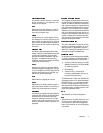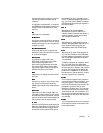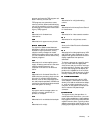
Glossary 11
An internal or external device—such as a
printer, a disk drive, or a keyboard—con-
nected to a computer.
Abbreviation for pin grid array, a type of
processor socket that allows you to re-
move the processor chip.
A single point on a video display. Pixels
are arranged in rows and columns to cre-
ate an image. A video resolution, such as
640 x 480, is expressed as the number of
pixels across by the number of pixels up
and down.
An industry-standard specification that
makes it easier to add hardware devices
to personal computers. Plug and Play
provides automatic installation and con-
figuration, compatibility with existing
hardware, and dynamic support of mobile
computing environments.
Acronym for power-on self-test. Before
the operating system loads when you turn
on your computer, the POST tests various
system components such as RAM, the
disk drives, and the keyboard.
Abbreviation for pages per minute.
Abbreviation for plastic quad flat pack, a
type of processor socket in which the pro-
cessor chip is permanently mounted.
The primary computational chip inside the
computer that controls the interpretation
and execution of arithmetic and logic
functions. Software written for one pro-
cessor must usually be revised to run on
another processor.
CPU
is a synonym for
processor.
The Program Diskette Maker allows you
to create program diskette sets, or master
copies, of software that Dell installed on
your computer system. It is essential that
you create these diskette sets as soon as
possible. You may need a set of master
diskettes if you ever experience problems
with your hard-disk drive and need to re-
install your Dell-installed software. If your
system includes Dell-installed software,
you can select this program from the Dell
Accessories program folder.
The set of diskettes from which you can
perform a complete installation of an op-
erating system or application program.
When you reconfigure a program, you of-
ten need its program diskette set.
An operating mode supported by 80286
or higher processors, protected mode al-
lows operating systems to implement:
A memory address space of 16 MB
(80286 processor) to 4 GB (Intel386
or higher processor)
Multitasking
Virtual memory, a method for
increasing addressable memory by
using the hard-disk drive
The Windows NT, OS/2, and UNIX
®
32-bit
operating systems run in protected mode.
MS-DOS cannot run in protected mode;
however, some programs that you can
start from MS-DOS, such as the Windows
operating system, are able to put the com-
puter into protected mode.
Abbreviation for Personal System/2.
Abbreviation for Preboot eXecution Envi-
ronment, which loads agents remotely
onto systems to perform management
tasks in the absence of a running operat-
ing system.


















